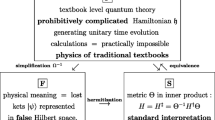Abstract
It has recently been shown that a non-Hermitian Hamiltonian H possessing an unbroken PT symmetry (i) has a real spectrum that is bounded below, and (ii) defines a unitary theory of quantum mechanics with positive norm. The proof of unitarity requires a linear operator C, which was originally defined as a sum over the eigenfunctions of H. However, using this definition it is cumbersome to calculate C in quantum mechanics and impossible in quantum field theory. An alternative method is devised here for calculating C directly in terms of the operator dynamical variables of the quantum theory. This new method is general and applies to a variety of quantum mechanical systems having several degrees of freedom. More importantly, this method can be used to calculate the C operator in quantum field theory. The C operator is a new time-independent observable in PT-symmetric quantum field theory.
Similar content being viewed by others
References
C.M. Bender:Czech.J.Phys.54 (2004)13.
C.M. Bender, P.N. Meisinger,and Q.Wang:J.Phys.A:Math.Gen.36 (2003)1973.
C.M. Bender, J.Brod, A.T. Re g,and M.E. Reuter:J.Phys.A:Math.Gen.(to be published).
C.M. Bender, G.V. Dunne, P.N. Meisinger,and M. Simsek:Phys.Lett.A 281 (2001) 311.
C.M. Bender, D.C. Brody,and H.F. Jones:hep-th/0402011.
C.M. Bender, D.C. Brody,and H.F. Jones:hep-th/0402183;toappearin Phys.Rev.D.
H.D.I. Abarbanel, J.D. Bronzan, R.L. Sugar,and A.R. White:Phys.Rep.21 (1975) R.Brower,M.Furman,andM.Moshe:Phys.Lett.B 76 (1978)213.
M.E. Fisher:Phys.Rev.Lett.40 (1978)1610. J.L.Cardy:Phys.Rev.Lett.54 (1985)1345. J.L.Cardy and G.Mussardo:Phys.Lett.B 225 (1989)275. A.B.Zamolodchikov:Nucl.Phys.B 348 (1991)619.
C.M.Bender, P.Meisinger,and H.Yang:Phys.Rev.D 63 (2001)45001.
C.M.Bender, K.A. Milton,and V.M. Savage:Phys.Rev.D 62 (2000)85001.
C.M. Bender and H.F. Jones:hep-th/0405113;to appear in Phys.Lett.A.
C.M.Bender, D.C. Brody,and H.F. Jones:Phys.Rev.Lett.89 (2002)270402; Am.J.Phys.71 (2003)1095.
C.M. Bender and G.V. Dunne:Phys.Rev.D 40 (1989)2739;3504.
C.M. Bender and S.A. Orszag:Advanced Mathematical Methods for Scientists and Engineers,McGraw-Hill, New York,1978,Chap.10.
C.M. Bender and S.Boettcher:Phys.Rev.Lett.80 (1998)5243.
Author information
Authors and Affiliations
Rights and permissions
About this article
Cite this article
Bender, C.M. Calculating the C Operator in PT-symmetric Quantum Mechanics. Czechoslovak Journal of Physics 54, 1027–1038 (2004). https://doi.org/10.1023/B:CJOP.0000044001.97758.c7
Issue Date:
DOI: https://doi.org/10.1023/B:CJOP.0000044001.97758.c7



